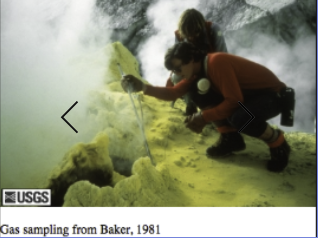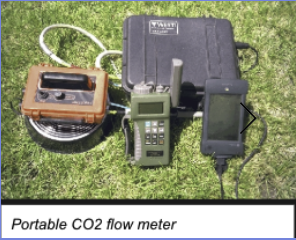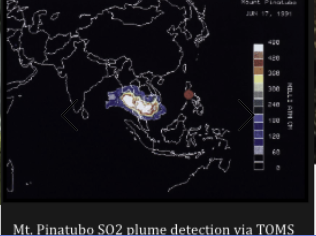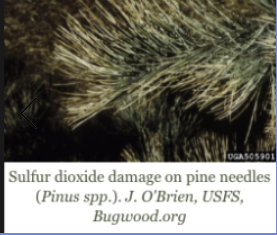Volcanic Gas Interactions with Plants
- Dasha Horton
- Jan 27, 2020
- 7 min read
ABSTRACT
Exposure to gases from volcanic activity creates a toxic atmosphere that devastates plant life within a volcanoes range. In a comparison of Carbon Dioxide (CO2) gas emitted from the Mammoth Crater and Sulfur Dioxide (SO2) being emitted by Mt. Kilauea it is evident that different chemical compositions of gases are very influential to an ecosystem. Although biomes are impacted in unique ways, in all cases the plants within any volcanic zone absorb materials that deteriorate the functions of the plants. In this essay, we investigate the correlation between gaseous hazards from volcanoes influencing the plant life with a specific focus on CO2 production as well as the outcomes of SO2 dispersal on plant communities.

INTRODUCTION
Volcanoes alter the environment and are found all over the planet. A volcano is a place where lava flows out from within the crust or mantle. When a volcano occurs there are often times more events than just lava flow. Earthquakes and gas dispersal also occur because of the tectonic activity below the crust. Tectonic plates are the formations of rigid crust laying over the flowing lithosphere. This is an important feature to volcanic activity since the movement of these plates influences the locations of volcanoes. Convergent, divergent, and transform boundaries all play a role in volcano creation. For this essay’s purpose researchers took into account that the Mammoth Crater is associated with a long transform fault and Mt. Kilauea from a false hotspot system related with subduction movement of the plate boundaries. This difference accounts for compounds created. Magma will have different chemical reserves depending on the composition of incorporated minerals and rocks and then super-heated into a gas state. Gases are an important factor in the life on the surface of the planet. Plants and animals both rely on the chemicals in the atmosphere and soil. Modern researchers understand how volcanoes impact the environment and note how biomes are affected when a volcano erupts. There are severe negative repercussions due to imbalances of certain chemicals, yet there are also some positive impacts from gas spread from volcanoes. Moreover, all of the research collected to understand chemical influences on plant communities is able to express how humans can better conserve natural life without a human-centric scope on the function of Earth.

RESULTS
Mammoth Mountain Mammoth Mountain in California is a prime example of gases affecting the environment around it. Earthquake activity below the mountain resulted in a steady extrusion of CO2 gases into the surrounding regions (USGS, N/A). Trees surrounding Mammoth Mountain are currently dying due to CO2 in the soil. The soil is composed of somewhere between 20-90% CO2, while normal soil CO2 levels are less than 1%. The concentration of CO2 in the soil surrounding Mammoth Mountain (and associated lake region) is continuously being monitored at 4 sites around the mountain. The rate at which CO2 comes out of the ground is monitored periodically at each area of tree kill (where the trees are dying) using a machine called a flow meter. The average flow of CO2 over a period of 3 years is 110 (give or take 24) metric tons per day. The give or take 24 metric tons is most likely caused by changes in atmospheric conditions such as wind speed, rather than an increase or decrease in flow from the deep gas reservoir

Mt.Kilauea
Mt. Kilauea is another example of volcanic destruction, specifically Sulfur Dioxide (SO2) gaseous hazards, impacting an ecosystem. In May 2018, this hot-spot volcano exploded through the surface of Hawaii’s largest island. Copious amounts of noxious gases disbanded into the atmosphere via the cracks in the crust. Sulfur Dioxide is a very corrosive and highly toxic irritant found in most volcanic events. Mt. Kilauea alone emits from 500 to 14,000 metric tons of gas into the atmosphere (“Volcanic gases can be harmful to health, vegetation, and infrastructure” USGS, 2017). At that rate of dispersal miles of continental biospheres are affected. The SO2 gets into water sources, resides in cloud formations (producing burning acidic rains), and ends up being taken up by the plant body vascular systems in millions of plant species. The diversity of plant life is directly endangered by the fluctuation of SO2 content. High Sulfur Dioxide can cause plants that are low SO2 tolerant to die off. This results in high SO2 tolerant plants to fill in the empty niche in the biome (Dale, et al, 2005). Widely diverse regions become more monocultural. Likewise, SO2 causes a smog-like haze to surround the volcanic crater (then dispersed by wind) creating a layer of low light accessibility (Marti and Ernst, 2005). This lack of light is proportional to plant die-off due to a lack of energy source from the sun in the carbohydrate producing photosynthesis process (“Sulfur Dioxide Damage to Plants” n.d.). Although SO2 causes so many problems it is also an instigator for global cooling which helps control climate change. Volcanic gases may be extremely dangerous, but there are some merits to the natural process of destruction and chemical recycling.
The Benefits of Volcanic Gases
The negative effects that volcanic gases have on plant life are important to note and discuss so that we may learn how we are able to take action to protect our planet. However, volcanic gases can also have positive effects on surrounding plant life. For example, a notable benefit of volcanic eruptions is the emission of carbon dioxide. While this may no longer apply to the condition of our planet presently, before human beings started contributing to the massive growth of greenhouse gases into the atmosphere, the burst of CO2 following an eruption would help plant life thrive, due to the gas being necessary for photosynthesis (Greentumble, 2015). In our current climate, the production of CO2 via volcanic activity isn’t as beneficial, but it is not as harmful either, at least in terms of climate change. A volcanic explosion doesn’t emit enough CO2 into our atmosphere to drastically change the climate. In fact, it has been discovered that a volcanic eruption releases less than one percent of the carbon dioxide that is currently being released by humans (Matthews, 2018). For example, when Mount St. Helens erupted in 1980, it released about 10-million tons of CO2 into the atmosphere over the course of nine hours. While this is a staggering amount of CO2, humans are capable of emitting the same amount in only 2.5 hours (Volcanoes Can Affect the Earth’s Climate, 2018).
Additionally, while SO2 presents significant problems to plant life in terms of acid rain, as discussed prior, it also possesses the ability to contribute towards global cooling. While global cooling can also pose threats to the environment, such as producing long and harsher winters, it may also provide relief to third world countries in more tropical climates. Global warming in tropical climates can contribute to the loss of 200 growing days per year (Worland, 2015). This loss can be devastating, not only to the vegetation but also financially for the farmers in third world countries in these regions. While a balance between global cooling and global warming is desired, global cooling can help contribute to the growth of plants in areas that may not have been directly affected by a volcanic eruption, but rather, affected by the gases that are emitted and spread across the globe.
METHODS
Volcanic research is a dangerous endeavor and, although up-close data analysis is accurate, there is a great deal of technology that helps collect data. CO2 and SO2 readings are collected through spectrometry devices which calculate the amount of light passing through volcanic gases resulting in a reading and reflecting on how much gaseous elements are being dispersed from a volcanic rupture. Plant analysis is another feature of this research that is important. Plants are put through various tests to calculate how much CO2, SO2, or other gas is being observed and how that is affecting the plant. When Plants encounter high levels of SO2 the ends of the leaves begin to deteriorate due to a lack of Oxygen. Researchers can visually note which plants are being affected by high levels of a gas and then take cutting which they put through an analytical mechanism (Tsutsumi et al. 2014).
CONCLUSION
Through volcanic gas analysis in the two examples mentioned above, it is evident that the rates at which gaseous chemicals are emitted are detrimental to small communities around the region of dispersal. On a broader scale, the effects dissipate and nature is able to either reclaim the regions or diversify to create a better-adapted biome. Although the effects of volcanoes are reconcilable, the ways in which human activity couples with it is detrimental in all aspects. There are many cases of human interaction with plant biomes that do not take into consideration other natural forces, such as volcanic activity. Plant communities are unable to recuperate when there are human factors: physical traffic, runoff and agriculture depositions, CO2 and other chemical output from industrial plants and combustion engines. The planet has its own natural events that occur because that is the way the ecosystem function. Plate tectonics cannot be stopped, and neither can volcanic gas emission, yet the majority of human activity hinges on the concept that the human experience is the only important activity on this planet. Human actions can be controlled to benefit re-growth and diversification. There are many aspects to human impact on the environment, yet it is important to consider the natural occurrence as well since those cannot be changed. As a final reflection of the research discussed above, the perpetuation of large chemical deposition into the environment by volcanoes is mediocre compared to the human expulsion. Further research will show how humans can respectfully help the environment not deteriorate further as the progression of this millennia continues.
CITATIONS
[1] “Invisible CO2 Gas Killing Trees at Mammoth Mountain, California | USGS Volcano Fact Sheet”
[2] “Natural Hazards”, USGS, 2017, https://www.usgs.gov.
[3] Virginia H. Dale, Johanna Delago-Acevedo, James MacMahon, “Effects of Modern Volcanic Eruptions on Vegetation” Cambridge University Press, 2005
[4] Joan Marti and Gerald G.J Ernst, “Volcanoes and the Environment”,Cambridge University Press, 2005
[5] Koichi Tsutsumi et al., “Sites of Action of Elevated CO2 on Leaf Development in Rice: Discrimination between the Effects of Elevated CO2 and Nitrogen Deficiency,” Plant and Cell Physiology 55, no. 2 (February 1, 2014): 258–68, https://doi.org/10.1093/pcp/pcu006.
[6] "Volcanoes Can Affect the Earth's Climate", USGS, 2018, https://volcanoes.usgs.gov/vhp/gas_climate.html
[7] "Is Volcanic Activity Beneficial for the Earth?", Greentumble, 2015, https://greentumble.com/is-volcanic-activity-beneficial-for-the-earth/
[8] "The Weird Effect Climate Change Will Have On Plant Growth", Justin Worland, 2015, http://time.com/3916200/climate-change-plant-growth/
[9] “Invisible CO2 Gas Killing Trees at Mammoth Mountain, California | USGS Volcano Fact Sheet,” accessed December 11, 2018, https://pubs.usgs.gov/dds/dds-81/Intro/facts-sheet/GasKillingTrees.html.
[10] “USGS: Volcano Hazards Program,” accessed December 11, 2018, https://volcanoes.usgs.gov/vhp/gas.html.
[11] Lyndsey Matthews, “Acid Rain, Volcanic Smog, and ‘Ballistic Projectiles’ Are in the Forecast for Hawaii,” Popular Mechanics, May 10, 2018, https://www.popularmechanics.com/science/environment/a20637303/acid-rain-hawaii-volcano-e ruption-2018/.
[12] “Sulfur Dioxide Damage to Plants,” accessed December 11, 2018, http://www.missouribotanicalgarden.org/gardens-gardening/your-garden/help-for-the-home-gar dener/advice-tips-resources/pests-and-problems/environmental/sulfur-dioxide.aspx.
[13] Linda W. Cuddihy “VEGETATION ZONES OF THE HAWAIIAN ISLANDS,” http://manoa.hawaii.edu/hpicesu/book/1988_chap/13.pdf
[14] “Sulfur Dioxide Effects on Health - Air (U.S. National Park Service),” accessed December 11, 2018, https://www.nps.gov/subjects/air/humanhealth-sulfur.htm.
[15] “Volcanic Gases,” accessed December 11, 2018, http://volcano.oregonstate.edu/book/export/html/151.
[16] “USGS: Volcano Hazards Program,” accessed December 11, 2018, https://volcanoes.usgs.gov/vhp/gas_climate.html.
[17] “Is Volcanic Activity Beneficial for the Earth? | Greentumble,” accessed December 11, 2018, https://greentumble.com/is-volcanic-activity-beneficial-for-the-earth/.
[18] Images via wikimedia
[19] Mammoth Mountain paragraph by Danna Facer
[20] Benefits of Volcanic Gas paragraph by Shelby Young






Comments